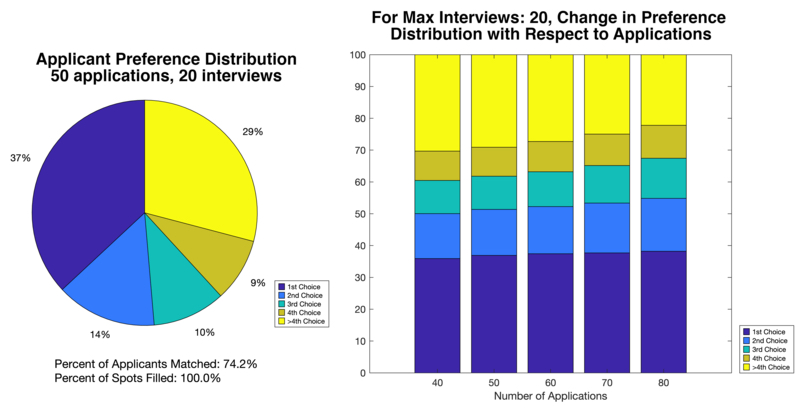Back
Poster, Podium & Video Sessions
Moderated Poster
MP10: Education Research I
MP10-14: Modeling The Urology Residency Application and Match Process: A Mathematical Argument for Application and Interview Limits
Friday, May 13, 2022
1:00 PM – 2:15 PM
Location: Room 228
Sameer Farooq*, Akanksha Mehta, Atlanta, GA
.jpg)
Sameer Farooq, MD
Emory University
Poster Presenter(s)
Introduction: The competitive nature of the Urology match has led to an untenable environment for applicants, who feel pressured to apply to >70 programs, and for residency programs, which receive hundreds of applications for a limited number of training positions. We used a mathematical model to investigate the effect of an application and interview cap on the urology match success rate.
Methods: Using 2020-2021 AUA data, we created a mathematical model in MATLAB that simulated 481 applicants applying to a total of 357 training positions distributed across 143 urology residency programs. Applicants were divided into top (1/5), middle (3/5), and bottom (1/5) strata. Programs were divided into three equally sized strata (1/3, 1/3, 1/3) based on Doximity rankings. The goal was to optimize the match rate and fill all available training positions.
We made the following assumptions:
1) all programs stratify applicants in the same way, and vice versa 2) all applicants/programs within a specific stratum are considered equivalent 3) all applicants apply to the maximum number of programs.
In the model, we modified the maximum number of applications and interviews per applicant, created pseudo-random rank lists that preferentially ordered applicants and programs based on top > middle > bottom strata, and ran a simulated match. Each scenario was repeated 1000 times.
Results: Application caps and interview caps for applicants were associated with programs’ ability to interview enough candidates to fill all available training spots. However, this effect disappeared at an application cap of 50 and interview cap of 20
When looking at match results with an interview cap of 20, the preference distribution of applicants remained stable when changing the application cap, indicating that above a certain threshold, more applications do not provide additional benefit. Conversely, as the caps were further reduced, the preference distribution was negatively affected.
Conclusions: Based on the results of our simulated model, match parameters were optimized at a maximum of 50 applications and 20 interviews per applicant. Such limits would reduce cost and time burden for both programs and applicants and likely result in no deleterious effects, while still reducing average applications by at least 35% from the 2020-2021 cycle.
Source of Funding: None

Methods: Using 2020-2021 AUA data, we created a mathematical model in MATLAB that simulated 481 applicants applying to a total of 357 training positions distributed across 143 urology residency programs. Applicants were divided into top (1/5), middle (3/5), and bottom (1/5) strata. Programs were divided into three equally sized strata (1/3, 1/3, 1/3) based on Doximity rankings. The goal was to optimize the match rate and fill all available training positions.
We made the following assumptions:
1) all programs stratify applicants in the same way, and vice versa 2) all applicants/programs within a specific stratum are considered equivalent 3) all applicants apply to the maximum number of programs.
In the model, we modified the maximum number of applications and interviews per applicant, created pseudo-random rank lists that preferentially ordered applicants and programs based on top > middle > bottom strata, and ran a simulated match. Each scenario was repeated 1000 times.
Results: Application caps and interview caps for applicants were associated with programs’ ability to interview enough candidates to fill all available training spots. However, this effect disappeared at an application cap of 50 and interview cap of 20
When looking at match results with an interview cap of 20, the preference distribution of applicants remained stable when changing the application cap, indicating that above a certain threshold, more applications do not provide additional benefit. Conversely, as the caps were further reduced, the preference distribution was negatively affected.
Conclusions: Based on the results of our simulated model, match parameters were optimized at a maximum of 50 applications and 20 interviews per applicant. Such limits would reduce cost and time burden for both programs and applicants and likely result in no deleterious effects, while still reducing average applications by at least 35% from the 2020-2021 cycle.
Source of Funding: None


.jpg)
.jpg)